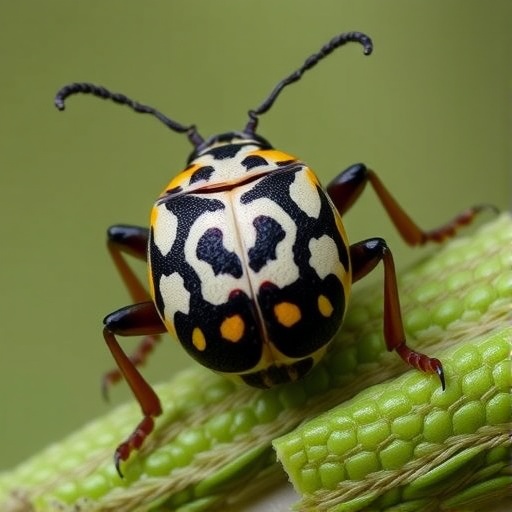In newly published research, the intricacies of the midgut symbiotic organ in stinkbugs have been meticulously examined, shedding light on the extraordinary adaptations and structural nuances that facilitate the creature’s survival and symbiotic relationships. The study focuses on the species Plautia stali, a prominent member of the Pentatomidae family, laying the groundwork for a broader understanding of symbiotic relationships in insects. This investigation emerges at a time when ecological relationships are under increased scrutiny, given their critical role in the health of ecosystems and influence on agricultural practices.
Symbiotic organisms play pivotal roles in their hosts’ digestive processes, nutrient acquisition, and overall physiological function. In the world of insects, particularly within the Hemiptera order, the midgut of these organisms hosts a plethora of microbial life that aids in the digestion of otherwise indigestible plant materials. The extensive research spearheaded by Harumoto, Moriyama, and Fukatsu represents a significant leap forward, offering new insights into the development stages of these microbial partnerships and their structural adaptations within the midgut.
The findings suggest that the midgut symbiotic organ in Plautia stali is marked by several unique structural adaptations during its early developmental stages. This organ is not merely a passage for ingested materials; rather, it appears to be a complex ecosystem that promotes coexistence between the insect and its symbiotic microbes. Such an arrangement not only aids in survival but can also enhance the insect’s ability to assimilate nutrients effectively, thus ensuring its longevity and reproductive success.
In examining the early stages of development, researchers have documented changes in the composition and configuration of the midgut organ, indicating a dynamic adaptation process. These stages are characterized by marked transformations, from the initial cell arrangements to the eventual establishment of functional symbiotic systems. Harumoto and his colleagues meticulously describe how these structural features serve a dual purpose: supporting insect physiology while simultaneously fostering a conducive environment for microbial life.
The relationship between stinkbugs and their symbiotic microorganisms is impressively specialized. This study reveals that certain microbial populations are selected for their utility in breaking down complex carbohydrates found in the stinkbug’s diet, primarily derived from plant materials. The midgut symbiotic organ becomes a selective arena where beneficial microbes thrive while pathogenic or non-contributing microbes are minimized, hinting at a sophisticated form of microbial governance within this niche environment.
Furthermore, the researchers employed advanced imaging techniques to elucidate the architecture of the midgut organ, leading to astonishing discoveries about its compartmentalization. The midgut, often perceived as a single entity, is revealed to comprise multiple specialized regions, each playing a distinct role in digestion and microbial fermentation. This compartmentalization not only enhances digestibility but allows for a more efficient resource allocation as nutrients are processed.
Through evolutionary lenses, the study reflects on the adaptive significance of the midgut symbiotic organ. Over countless generations, these structural adaptations have enabled Plautia stali to optimize its energy intake and thrive in various ecological contexts. The findings resonate with longstanding theories in evolutionary biology regarding the co-adaptation of organisms in mutualistic relationships, underscoring the complexity of these interspecies alliances.
The implications of this research extend beyond mere anatomical observations. As scientists clarify how the midgut structures of stinkbugs evolve to accommodate their symbionts, the knowledge gained may provide insight into similar systems across different insect taxa. This could pave the way for advancements in sustainable pest management strategies, where understanding these relationships could lead to innovative biological control measures.
Moreover, Harumoto et al.’s findings may enhance agricultural practices by elucidating how symbionts can impact plant health and growth. If scientists can manipulate these microbial communities within pest insects, it could potentially lead to methods that reduce crop damage, promoting healthier and more sustainable agricultural ecosystems.
In conclusion, the pioneering work of Harumoto, Moriyama, and Fukatsu offers profound insights into the complex relationship between stinkbugs and their symbiotic partners. The study not only enriches our understanding of insect physiology and development but also poses significant questions about the broader implications of symbiosis in ecological balance. As ongoing research continues to unravel the complexities of these relationships, one can anticipate a deeper appreciation for the intricate web of life that sustains our ecosystems.
The exploration of midgut symbiotic organs in insects represents a captivating frontier in biological research. It raises questions about the interconnectedness of life forms and how they co-evolve in response to environmental pressures and changes. Researchers are now more motivated than ever to delve into the depths of insect microbial communities, unlocking further secrets that nature holds. Ultimately, this research serves as a reminder of the incredible diversity found in adaptation strategies, adding layers to our understanding of life on Earth.
Subject of Research: Peculiar structural features of midgut symbiotic organ in the early development of the stinkbug Plautia stali.
Article Title: Peculiar structural features of midgut symbiotic organ in the early development of the stinkbug Plautia stali Scott, 1874 (Hemiptera: Pentatomidae).
Article References: Harumoto, T., Moriyama, M. & Fukatsu, T. Peculiar structural features of midgut symbiotic organ in the early development of the stinkbug Plautia stali Scott, 1874 (Hemiptera: Pentatomidae). Sci Nat 112, 34 (2025). https://doi.org/10.1007/s00114-025-01986-0
Image Credits: AI Generated
DOI: https://doi.org/10.1007/s00114-025-01986-0
Keywords: Symbiosis, Plautia stali, Pentatomidae, Midgut Structure, Developmental Biology, Insect Physiology, Microbial Communities, Evolutionary Biology, Agricultural Implications, Eco-Biology.




